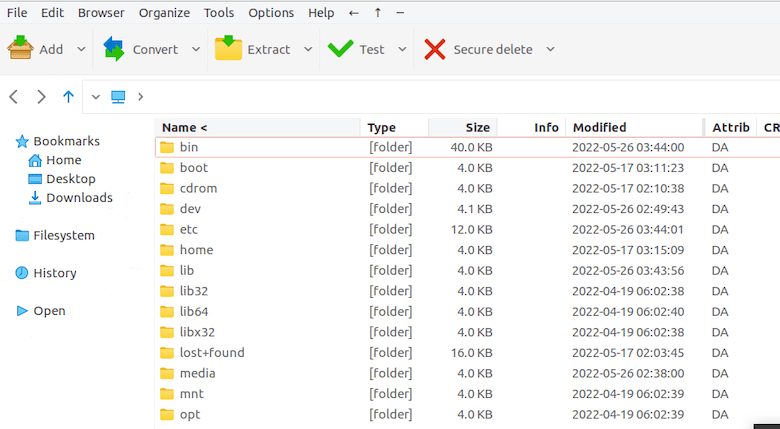How To Install PeaZip on Linux Mint 22

In this tutorial, we will show you how to install PeaZip on Linux Mint 22. Linux Mint 22, known for its user-friendliness and robust features, provides an excellent platform for utilizing powerful archive management tools. PeaZip stands out as a versatile and feature-rich archive manager that supports a wide array of file formats, offers strong encryption options, and seamlessly integrates with various desktop environments.
This article aims to guide you through the process of installing PeaZip on Linux Mint 22, providing step-by-step instructions and valuable insights along the way. Whether you are a beginner or an experienced Linux user, this comprehensive guide will ensure a smooth and successful installation. You’ll learn not only how to install PeaZip using different methods but also how to configure it to suit your specific needs. Let’s explore the world of PeaZip and discover how it can enhance your file management capabilities on Linux Mint 22.
Understanding PeaZip
PeaZip is more than just an archive manager; it’s a comprehensive utility that handles a vast range of archive formats, from common ones like ZIP and TAR to more specialized formats. Its robust feature set includes file compression, encryption, splitting, and joining capabilities, making it an indispensable tool for anyone working with archives on Linux Mint 22.
Key Features
- Support for 200+ Archive Formats: PeaZip supports an extensive list of archive types, including 7Z, ZIP, TAR, GZIP, BZIP2, XZ, and many more. This broad compatibility ensures you can handle virtually any archive you encounter.
- File Compression Capabilities: PeaZip offers advanced compression options, allowing you to reduce file sizes effectively. It supports multiple compression algorithms, enabling you to optimize archives for storage or transmission.
- Security Features: Security is a paramount concern, and PeaZip addresses this with robust encryption capabilities. It supports AES encryption, password protection, and secure deletion, ensuring your sensitive data remains safe.
- Integration with File Manager: PeaZip seamlessly integrates with popular file managers like Nemo in Linux Mint, adding archive management capabilities to your desktop environment. This integration simplifies your workflow and enhances productivity.
Prerequisites
Before proceeding with the installation of PeaZip on Linux Mint 22, it’s important to ensure that your system meets certain prerequisites. These preparatory steps will help prevent potential issues and ensure a smooth installation process.
- System Requirements: Linux Mint 22 is a relatively lightweight distribution, but PeaZip still requires adequate system resources to function efficiently. Ensure you have sufficient RAM and free disk space.
- Backup Recommendations: It’s always a good practice to back up your system before installing new software. This precaution can save you from potential data loss in case something goes wrong during the installation.
- Internet Connection: An active internet connection is required to download PeaZip packages and dependencies from the official website or software repositories.
- Administrative Privileges: You’ll need administrative privileges (sudo access) to install PeaZip, regardless of the installation method you choose.
Installation Methods
There are several methods to install PeaZip on Linux Mint 22, each with its own advantages and suitability for different user preferences. We will cover three primary methods: using a DEB package, installing via the Software Manager, and utilizing Flatpak.
Method 1: Using DEB Package
Installing PeaZip using a DEB package involves downloading the package from the official website and then installing it via the command line or a graphical interface. This method provides the latest version of PeaZip directly from the source.
- Downloading from Official Website:
- Open your web browser and navigate to the official PeaZip website or a trusted source like SourceForge.
- Locate the DEB package for Linux Mint 22. Make sure to select the correct architecture (32-bit or 64-bit) that matches your system.
- Click the download link and save the DEB package to your preferred directory.
- Installation Steps Using GUI:
- Open the file manager (Nemo) and navigate to the directory where you saved the DEB package.
- Right-click on the DEB package and select “Open with” or “Install with Software Install.”
- The Software Install tool will open, displaying information about PeaZip.
- Click the “Install” button to begin the installation.
- Enter your administrative password when prompted.
- Wait for the installation to complete. The Software Install tool will notify you when PeaZip is successfully installed.
- Terminal Installation Commands:
- Open a terminal window.
- Navigate to the directory where you saved the DEB package using the
cdcommand. For example:
cd Downloads- Use the
dpkgcommand to install PeaZip. The command syntax is:
sudo dpkg -i peazip-version.deb- Replace
peazip-version.debwith the actual filename of the DEB package you downloaded. - After running the
dpkgcommand, you may encounter dependency errors. To resolve these errors, use the following command:
sudo apt-get install -f- This command will automatically resolve and install any missing dependencies.
- Wait for the installation to complete. Once finished, PeaZip will be installed on your system.
- Troubleshooting Common Issues:
- Dependency Errors: If you encounter dependency errors during the
dpkginstallation, use thesudo apt-get install -fcommand to resolve them. - Package Corruption: If the DEB package is corrupted, download it again from the official website to ensure you have a valid file.
- Permissions Issues: Ensure you have the necessary administrative privileges to install the package. Use
sudowhen running the installation commands.
- Dependency Errors: If you encounter dependency errors during the
Method 2: Software Manager Installation
The Software Manager in Linux Mint provides a user-friendly interface to search for and install applications. Installing PeaZip via the Software Manager is a straightforward process, ideal for users who prefer a graphical approach.
- Accessing Software Manager:
- Click the “Menu” button in the bottom-left corner of your screen.
- Type “Software Manager” in the search bar and click the “Software Manager” icon to launch the application.
- Search and Installation Process:
- In the Software Manager window, click the search icon in the top-right corner.
- Type “PeaZip” in the search bar and press Enter.
- The search results will display PeaZip. Click on the PeaZip entry to view more details.
- Click the “Install” button to begin the installation.
- Enter your administrative password when prompted.
- Wait for the installation to complete. The Software Manager will notify you when PeaZip is successfully installed.
- Post-Installation Verification:
- After the installation, you can verify that PeaZip is installed correctly by searching for it in the “Menu.” Type “PeaZip” and click the PeaZip icon to launch the application.
- Benefits of This Method:
- Ease of Use: The Software Manager provides a simple and intuitive interface for installing applications.
- Automatic Updates: Applications installed via the Software Manager are automatically updated along with the rest of your system.
- Dependency Management: The Software Manager automatically handles dependencies, ensuring that all required packages are installed.
Method 3: Flatpak Installation
Flatpak is a universal package management system that allows you to install applications that are isolated from the rest of your system. This method is particularly useful for keeping PeaZip updated and avoiding conflicts with system libraries.
- Setting Up Flatpak Support:
- Linux Mint 22 comes with Flatpak support pre-installed. However, if it’s not enabled, you can set it up by opening a terminal and running the following command:
sudo apt install flatpak- After installing Flatpak, add the Flathub repository, which is the primary source for Flatpak applications:
flatpak remote-add --if-not-exists flathub https://flathub.org/repo/flathub.flatpakrepo- Restart your system to apply the changes:
sudo reboot - Installation Commands:
- Open a terminal window.
- Use the following command to install PeaZip via Flatpak:
flatpak install flathub io.github.peazip.PeaZip- Confirm the installation by typing “y” when prompted.
- Wait for the installation to complete. Flatpak will download and install PeaZip and its dependencies.
- Update Procedures:
- To update PeaZip via Flatpak, use the following command:
flatpak update- This command will update all Flatpak applications installed on your system, including PeaZip.
- Advantages of Flatpak Method:
- Isolation: Flatpak applications are isolated from the rest of your system, reducing the risk of conflicts.
- Latest Versions: Flatpak often provides the latest versions of applications.
- Security: Flatpak applications are sandboxed, enhancing security.
Post-Installation Setup
After successfully installing PeaZip on Linux Mint 22, it’s time to configure it to suit your preferences. These post-installation steps will help you integrate PeaZip seamlessly into your workflow.
- File Manager Integration:
- PeaZip typically integrates with the default file manager (Nemo) automatically. You should be able to right-click on archive files and see PeaZip options in the context menu.
- If integration is not automatic, you can configure it manually through PeaZip’s settings. Open PeaZip and navigate to “Options” > “Settings” > “Integration.” Check the boxes to enable integration with your file manager.
- Default Application Settings:
- Open PeaZip and navigate to “Options” > “Settings” to configure the default application settings.
- You can set the default compression level, archive format, and extraction directory.
- Customize the user interface by changing the theme, icons, and language settings.
- Customizing Preferences:
- PeaZip offers a wide range of customization options. You can configure keyboard shortcuts, file associations, and archive handling preferences.
- Explore the “Options” > “Settings” menu to discover and customize these features.
- Verifying Installation:
- To ensure that PeaZip is working correctly, create a test archive and extract it. Right-click on a file or folder, select “PeaZip,” and choose “Add to archive.” Then, extract the archive to verify the process.
Using PeaZip
Now that PeaZip is installed and configured, let’s explore some basic operations to get you started.
- Basic Operations:
- Creating Archives: Right-click on a file or folder, select “PeaZip,” and choose “Add to archive.” Specify the archive format, compression level, and encryption options.
- Extracting Files: Right-click on an archive file, select “PeaZip,” and choose “Extract here” or “Extract to…” Specify the extraction directory and any additional options.
- Advanced Features:
- Encryption: PeaZip supports AES encryption to protect your sensitive data. When creating an archive, select the encryption option and provide a strong password.
- Splitting Archives: You can split large archives into smaller parts for easier storage or transmission. Use the “Split” option when creating an archive.
- Joining Archives: To join split archives, select the first part of the archive and choose the “Join” option. PeaZip will automatically locate and join the remaining parts.

Troubleshooting
While installing and using PeaZip, you might encounter some common issues. Here are some troubleshooting tips to help you resolve them:
- PeaZip Not Launching:
- Ensure that all dependencies are installed. Use
sudo apt-get install -fto resolve any missing dependencies. - Check for conflicting applications or libraries. Close any unnecessary applications and try launching PeaZip again.
- Reinstall PeaZip using one of the methods described above.
- Ensure that all dependencies are installed. Use
- File Manager Integration Issues:
- Verify that PeaZip integration is enabled in the application settings.
- Restart your file manager or your system to apply the changes.
- Check for file association conflicts. Ensure that PeaZip is the default application for archive files.
- Compression and Extraction Errors:
- Ensure that the archive file is not corrupted. Download it again from the source if necessary.
- Check for sufficient disk space in the extraction directory.
- Verify that the archive format is supported by PeaZip.
Congratulations! You have successfully installed PeaZip. Thanks for using this tutorial for installing the PeaZip file archiver utility on Linux Mint 22 system. For additional help or useful information, we recommend you check the official PeaZip website.